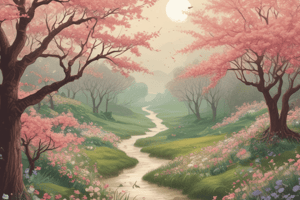Podcast
Questions and Answers
What is the symbolic significance of the 'Eden garden' in the poem?
What is the symbolic significance of the 'Eden garden' in the poem?
- A metaphor for the natural world
- A representation of the speaker's childhood
- A representation of sin and corruption
- A symbol of potential and harmony (correct)
What is the tone of the poem before the caesura?
What is the tone of the poem before the caesura?
- Joyful and celebratory (correct)
- Sombre and reflective
- Melancholic and introspective
- Critical and analytical
What is the effect of the internal rhyme and alliteration in the phrase 'fair their fling'?
What is the effect of the internal rhyme and alliteration in the phrase 'fair their fling'?
- It creates a sense of tension and conflict
- It interrupts the flow of the poem
- It adds to the overall sense of joy and energy (correct)
- It creates a sense of sadness and loss
What is the tone of the poem's opening lines?
What is the tone of the poem's opening lines?
What is the effect of the enjambment in the poem?
What is the effect of the enjambment in the poem?
What is the poet's concern in the sestet?
What is the poet's concern in the sestet?
Flashcards
Spring's Beauty
Spring's Beauty
Hopkins' poem celebrates the visual and auditory splendor of springtime, highlighting the flourishing of nature.
Edenic Imagery
Edenic Imagery
The poem connects spring to the Garden of Eden, implying a time of innocence and potential.
Hopkins' Style
Hopkins' Style
Hopkins uses striking imagery, assonance, alliteration, and challenging syntax to convey the poem's rich sensory experience.
Nature's Wonder
Nature's Wonder
Signup and view all the flashcards
Human Frailty
Human Frailty
Signup and view all the flashcards
Euphonic Alliteration
Euphonic Alliteration
Signup and view all the flashcards
Petrarchan Sonnet
Petrarchan Sonnet
Signup and view all the flashcards
Imagery in Spring
Imagery in Spring
Signup and view all the flashcards
Human Corruption
Human Corruption
Signup and view all the flashcards
Study Notes
Spring Poem by Hopkins
- The poem is a vivid depiction of the natural world in bloom during springtime, showcasing the beauty of the season.
- The poet considers spring on earth as a "strain of the earth's sweet being" in the Garden of Eden, evoking themes of innocence and potential.
Themes and Ideas
- The beauty of spring and the natural world
- A celebration of nature and its wonders
- Humanity's tendency to sin and the need for protection
- God's ability to safeguard the innocent
Style
- The poem employs imagery to capture the inscape of weeds and the sky
- Features striking assonance and euphonic alliteration
- Creates cacophony through alliteration in phrases like "Before it cloy, before it cloud"
- Exhibits challenging syntax in parts, such as "Most, O Maid's child, thy choice..."
- Written in the form of a Petrarchan sonnet
Analysis of Key Quotes
- "Nothing is so beautiful as Spring – / When weeds, in wheels, shoot long and lovely and lush;" - The poem opens with joyful and accessible language, using euphonic alliteration and assonance to describe the beauty of spring.
- "Thrush's eggs look little low heavens, and thrush / Through the echoing timber does so rinse and wring / The ear, it strikes like lightnings to hear him sing;" - The poem features vivid, visual imagery, including a unique simile comparing thrush's eggs to "little low heavens".
- "The glassy peartree leaves and blooms, they brush / The descending blue; that blue is all in a rush / With richness;" - The poem employs evocative imagery to capture the peartree and its leaves, and the image of the sky as a "descending blue" is particularly rich and vivid.
- "What is all this juice and all this joy? / A strain of the earth's sweet being in the beginning / In Eden garden.–" - The poem's religious symbolism is clear, with spring reminiscent of the potential and harmony represented by the Garden of Eden.
- "Have, get, before it cloy, / Before it cloud, Christ, lord, and sour with sinning, / Innocent mind and Mayday in girl and boy," - The poem shifts in tone, with the poet begging God to protect innocent youth from sinning and corruption.
Studying That Suits You
Use AI to generate personalized quizzes and flashcards to suit your learning preferences.



